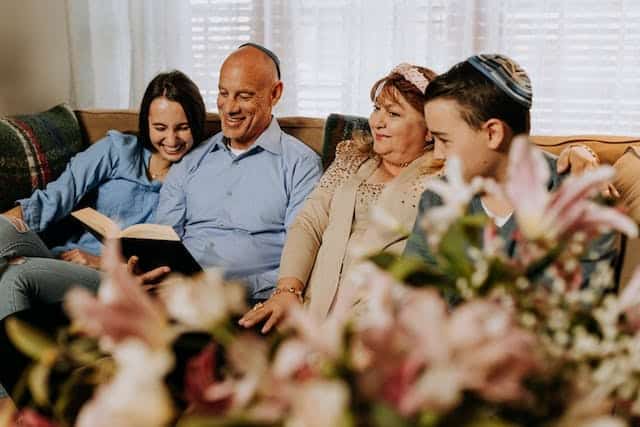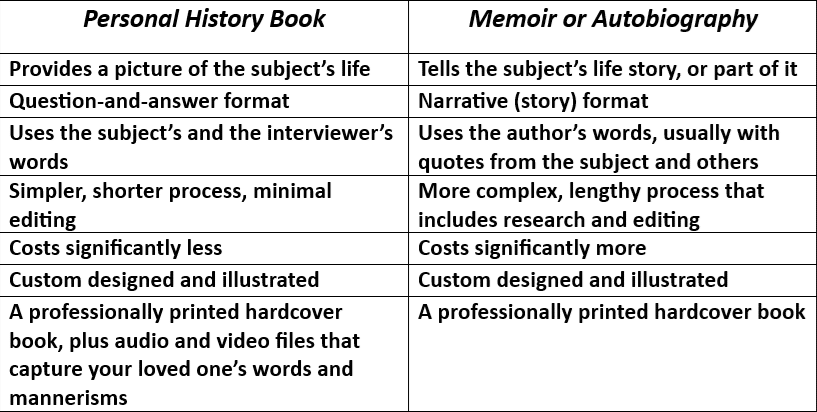Personal History Book—a Family Keepsake To Treasure
July 5, 2024
It’s hard to overstate the value of capturing and preserving a loved one’s own description of their journey through life. You can accomplish this by creating a personal history book, otherwise known as a keepsake book. It’s a doable project for most families.
An illustrated book that records your loved one’s memories in question-and-answer format makes a wonderful gift for a landmark birthday or retirement celebration. It shows your relative how much you value them, their story, and their contribution to the family heritage. It’s a perfect gift for that “someone who has everything” in your family.
Children, grandchildren, aunts, uncles, cousins, and friends can all play a part in the project, knowing that they’re helping to keep the family history and culture alive.
Through the book creation process and the book itself, each relative will discover some missing pieces of their own story—and connect the pieces they already knew.

The book will become a treasure that encircles and inspires current and future family members.
Flori Meeks, a senior writer with The Writers for Hire, who has worked on several personal history books, points to some reasons relatives choose to create them. “These people realize that they have memories of somebody, and they don’t want those things lost,” she says. “They want them to go on to other generations. Or maybe they feel they don’t know as much as they could about this person. We need to capture these stories while we can.”
Personal History Book Versus a Full-Length Biography or Memoir
A personal history book offers a simplified method of recording the memories of a single person for posterity. The table below shows similarities and differences between this type of book and a traditional memoir or autobiography.

The Process of Creating a Keepsake Memory Book
Here are steps to follow to turn this brilliant idea into a reality your family can keep for always:
- Contact a family history writer if you choose to use one. A respected writing company should get back to you in a timely manner to guide you through the process.
- Locate and set aside photos, documents, newspaper articles, and memorabilia. These may help your subject with recall. Some of the photos may also be good candidates for inclusion in the book.
- Set up a preliminary interview with family members. Before getting started, you’ll want to share your purposes for the book with relatives and get their input. What aspects of your loved one’s life would they like to know more about? What do they see as important to convey to coming generations?
- Hold the preliminary interview, either by phone, video chat, or in person. In this interview, you’ll share what motivates you to have the book completed. Then, as a family, arrive at a set of questions to be asked.
Each family member has their own collection of memories and knowledge about this loved one. The hour it takes to involve them in developing questions is time well spent getting them onboard and involved. It can also be fun!
- Schedule interviews with the book’s subject. It will probably take several hours of questions and answers to get a complete picture of your loved one’s life. It may be helpful to give them the list of questions in advance, so they’ll be more prepared. Also, ask them to look for photos or documents to help with their recall or to be included in the book. To avoid fatigue, it’s usually best to schedule at least two interviews to cover all your questions.
- Conduct interviews with the subject. It’s helpful to have one other person physically present to assist the interviewee with technology, repeat or explain questions, bring them snacks, or do whatever else is needed. A test run is also advisable, before the first complete interview, to be sure the technology being used is understood and functioning.
To ensure nothing is lost, use two methods of recording. For example, a small digital recording device and the recording feature on your video chat.
- Transcribe the interviews. Type out each question and answer from the interview to convert them into written form. Or, better yet, enlist the help of automated transcribers, to save you time. Just be sure to go back and ensure the transcription is accurate.
- Make any necessary changes and format your material. This includes selecting fonts and arranging questions and answers on the book’s pages. It also entails some minor editing to eliminate “umms” and “wells” and possibly rearrange the order of the questions and answers for logical flow.
- Have your keepsake memory book printed and delivered. There are multiple self-publishing options available online. Or keep reading to explore the option of using a professional writing company for your entire project, from initial contacts through interviews and printing.
Why hire a family history writer?
Hiring a seasoned writer or writing company with family history experience can make the process described above much smoother, more enjoyable, and a lot less work for you.
Your writer enters the picture at Step 3 above, helping to set up the preliminary interview, and is prepared with a set of questions for relatives to consider in advance. Family members may wish to leave some questions out, change some, or add to the list. Your writer is experienced at working with families and may have suggestions for questions specially tailored to your loved one.
The writer can also explain the scanning process and DPT requirements for photos.

While conducting interviews with your subject, a professional can keep the conversation from falling too far down a “rabbit hole” by skillfully directing it back to the question at hand.
An adept writer also knows how to get the most complete answers, even from reluctant interviewees.
A professional has the advantage of a level of objectivity that isn’t easy for family members to achieve and knows how to ask delicate questions delicately.
As part of a complete book package, a writer should handle the transcription, formatting, picture placement, and minor editing steps.
Your package should also include professional printing through a printer with whom the writer or writing company has connections. You should be able to order as many copies as you wish and expect to receive them within about six weeks. Besides hard copies, you should also receive both a PDF and digital files containing audio recordings of the interviews, so your loved one’s voice will never be lost.
Contrasting the enlistment of a writing company to create a question-and-answer personal history book with the same company’s production of a traditional book, Meeks comments, “You have a smaller team putting in less time on the project, and you still get something that’s really nice.”
Make it a group gift, announce it beautifully, and build on it later.
Maybe there are several family members who would like to contribute financially to a personal memory book to honor this loved one. If so, there are multiple online options that make giving “from all of us” gifts easy. One such site is payit2.com.
A creative medium for “giving” this special gift on a special occasion (or anytime!) is an artful letter, addressed to the subject, explaining the upcoming book project as well as why it is important to the family. This article features examples of beautiful presentation letters for this purpose.
A personal history book can become a priceless treasure. And you never know; this keepsake book might someday also become the foundation for a larger, more comprehensive family history book. A springboard for telling more family stories, past, current, and yet to come.






























